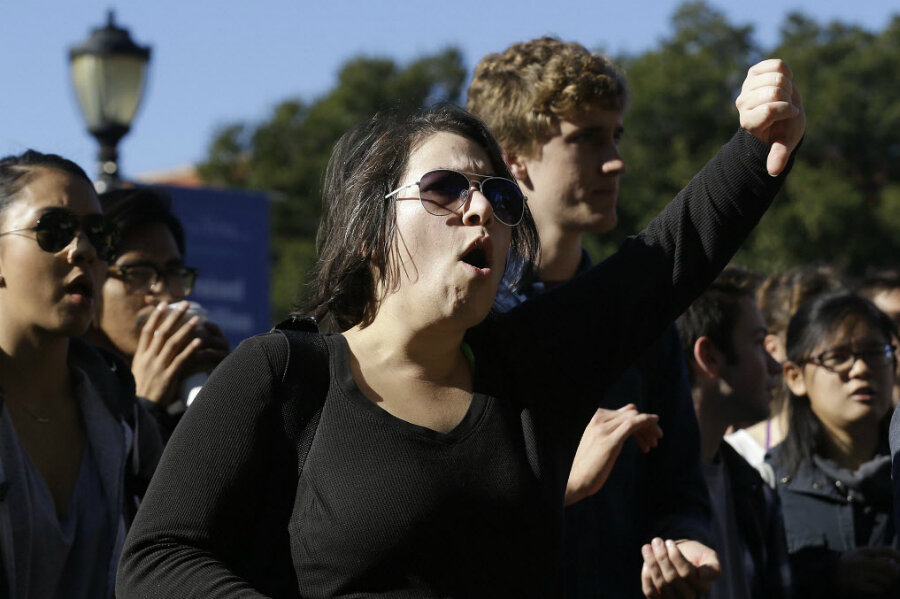In California, it's Jerry Brown vs. Janet Napolitano over UC tuition hike
Loading...
| Los Angeles
Protests are continuing Monday at University of California campuses after the UC Board of Regents last week approved a tuition increase of up to 5 percent in each of the next five years, ending a three-year tuition freeze.
Students are marching and staging sit-ins to protest a plan that would increase tuition from $12,192 annually to as much as $15,560 by 2019 for undergraduate California residents, and from $35,000 to nearly $45,000 for out-of-state students.
The episode is being watched closely across America for the lessons it could provide for several other states whose public universities are confronting rising costs during continued global financial challenges.
“This is happening in many states, and the California conflict is an example of this,” says Steven Schier, a political scientist at Carleton College in Northfield, Minn. “One aspect of this conflict is the need for the state to find revenue sources given its fiscal difficulties.”
In California, the situation has pitted hugely popular and just-reelected Gov. Jerry Brown against fellow Democrat and UC President Janet Napolitano, a former Arizona governor and US secretary of Homeland Security. Governor Brown has not only tried to block the tuition increase, but stated emphatically that he will seek to withhold a promised 4 percent increase (about $120 million) in UC's current funding in next year's state budget. He had asked the regents to postpone a vote until January to further examine how the university can cut costs in other ways.
“The pressure of not having enough money can force creativity that otherwise cannot even be considered,” said Brown, in an address to the regents last Wednesday in the run-up to regents' vote. The governor has hiked state funding 5 percent each of the past two years in a bid to ensure adequate funding during the tuition freeze.
But Ms. Napolitano cites a laundry list of reasons – rising retirement costs, the hiring of extra instructors, admitting more students – to make the case that the increase needs to be closer to 9 percent.
That position, if held by someone else, might not present much of a problem, but Napolitano’s stature is proving more formidable than Brown is used to in a university president.
“As a former governor, Napolitano is a tough adversary. She knows how the world looks from the other side of the table,” says Jack Pitney, professor of government at Claremont McKenna College in Claremont, Calif.
Napolitano notes that budget cuts – $1 billion per year – have already eliminated thousands of university jobs and argues that the three-year tuition freeze has threatened education quality.
In response, Brown proposes cost-cutting measures, citing the experience of the Universities of Texas, Michigan, and Virginia. These include upping dramatically the use of online courses, concentrating specialty courses at particular campuses, and giving college credit for work experience.
While some hold that those are all signs of a slipping education system, several analysts praise Brown for holding the line on costs in a state that has recovered somewhat with tax revenue increases but is far from out of the economic woods.
“California has had on-time budgets lately, but Brown is smart enough not to believe the fiscal happy talk by his reelection campaign,” Professor Pitney says. “He favors austerity because he knows that future budgets will be tighter. Winter is coming.”
Some education insiders question whether this isn’t the time for UC to do more than it has already done in cutting costs to a level that the state and students can afford.
“The governor wants the UC to cut costs; President Napolitano says they have done and will continue to do so. But the sorts of cuts she is discussing are keeping core activities as they are,” says William Tierney, director of the Pullias Center for Higher Education at the University of Southern California in Los Angeles. “Are there not more drastic measures that could be entertained that would maintain quality?”
The highest-profile activism has been at the Berkeley campus, where students have occupied Wheeler Hall in what they are calling a “symbolic reclamation of higher education.” Monday’s rallies and marches include scheduled stops at Berkeley High School and Berkeley City College.
“This is supposed to be a public university that is accessible to everyone no matter your financial resources,” student organizer Hannah Berkman told the San Francisco Chronicle. “Education is a right, and these tuition hikes are turning it into a privilege.”
UC tuition is already well above the national average of about $9,100. The state supplies about $2.8 billion of the university system’s nearly $7 billion operating budget.
Others feel that Brown is likely to prevail, ultimately. But the presence of Napolitano, they say, signals a formidable foe within his own party for his fourth term as governor.
“How can a relative newcomer to the state, Janet Napolitano, beat The Chosen One, newly reelected Gov. Jerry Brown, at this battle?” asks David McCuan, political scientist at Sonoma State University in Rohnert Park, Calif. “He is likely to ultimately win the war but the behind-the-scenes wrangling here is fascinating.
"The political kabuki theater that is the politics of higher education is ... the newest example of what is to come: Jerry Brown is going to have more policy battles, turf wars, and political problems with Democrats."







